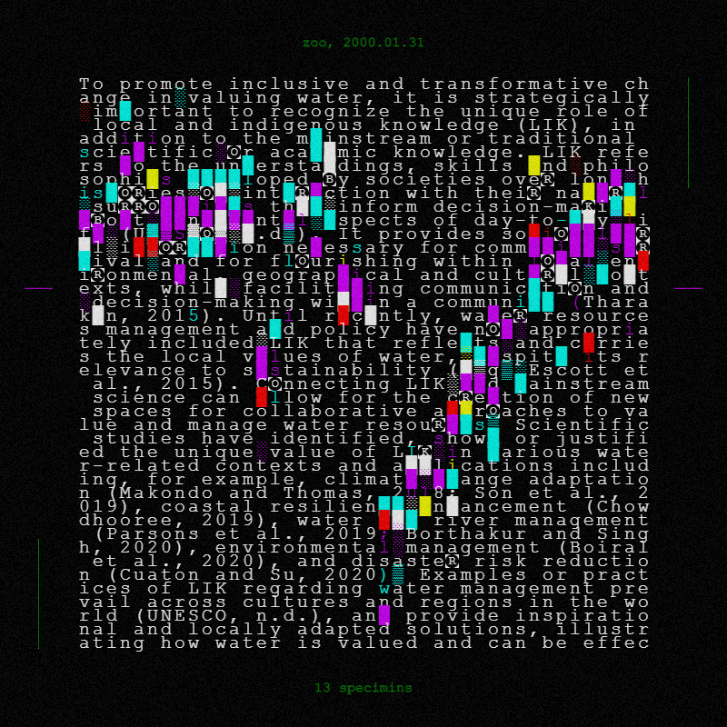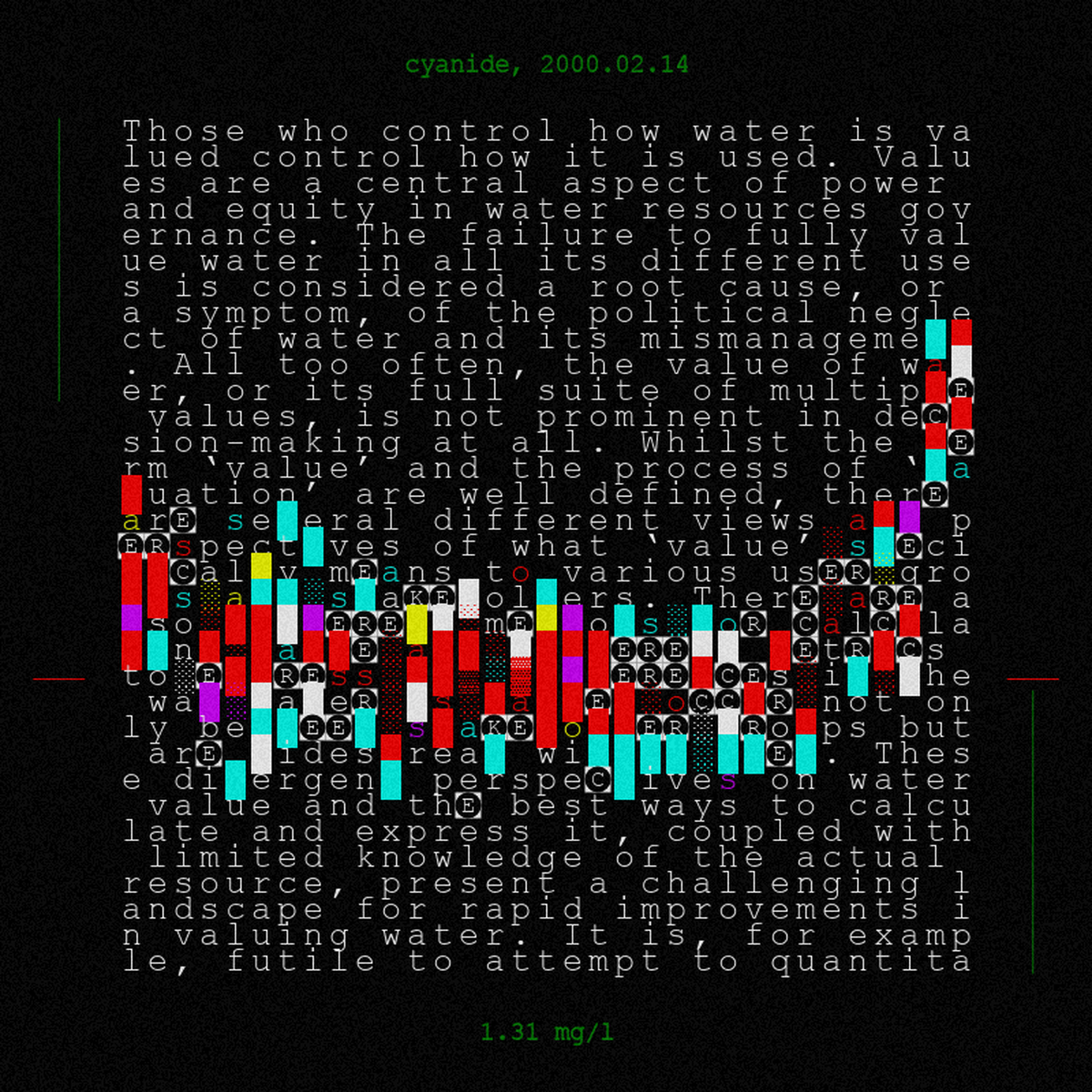
Hydro Gen: Audiovisual Poetry for Water in Crisis
written by Kalen Iwamoto
Hydro Gen is a generative and poetic artwork about water, environmental disaster, the interdependence of humans and nature, the destruction we wreak and the devotion we owe.
The project was created by a multidisciplinary team — conceptual writer and artist Kalen Iwamoto, generative artist and creative coder Vitalii Shumanskyi, interdisciplinary artist Nayven Vignette, and engineer and blockchain enthusiast Tamás Béke — as part of NFT DEB’s 7-day hackathon, in which several groups of artists, scientists, and data analysts were tasked with offering solutions to the water crisis through a visual art project. Organized by Viola Lukács, Peter Weiler, and Dr. Béla Lóránt Kovács, NFT DEB Generative Dimensions is an annual hackathon and conference that brings together science, art, and ethics to explore the development and potential of AI, data science, blockchain, the arts and creativity, within the framework of collective European values and interests.
project name project name project name
The theme: Water
This year, the theme of the hackathon was threats to surface freshwater, as seen through the disaster that befell the Tisza river, and the teams were challenged to create within the allotted time an artwork based on data provided by NFT DEB.
In January 2000, a dam containing toxic waste from the Baia Mare gold mine in Romania burst, dumping 100,000 cubic meters of cyanide-contaminated water through the Somes river and into the Tisza river. The spill decimated wildlife across four countries and threatened the welfare of millions of people. This was the first of a sequence of events over the course of two months that would be described as one of the gravest environmental disasters in central Europe since Chernobyl.
Many worldwide threats to all the interlinked parts of our ecosystems have been well documented and researched. Yet the Baia Mare spill is a striking example of how the value of water, in particular, varies drastically between different people and organizations. Profit-driven companies and economy-focused governments seem more than willing to risk the well-being of numerous lives–both human and not.
Artistic intent and team’s approach
The concept for the generative artwork hinges on the interdependence of humans and nature. The textual backdrop of the pieces introduces the human element of language, our common signifying system. These passages are excerpts from UNESCO’s 2021 World Water Development Report on the theme of valuing water. Traversing these pronouncements on the value of water is a graph that visualizes data by WWF on the levels of cyanide and the devastation and eventual revival of the populations of phytoplankton and zooplankton in the Tisza river following the Baia Mare disaster.
By superimposing these two systems into a single frame, we illustrate how intimately and inextricably they are bound together — the devastation of the Tisza river’s ecological system activates the veiling of the text and its breakdown in meaning, but hidden in the wave of ecological disaster is a (re)generative love poem to water — a tributary text, if you will — that bears witness to its ever-changing, multifaceted beauty and power.
Within the data wave, one glimpses some letters left uncovered, either encircled or colored. These two letter types come from two sets of words — one category of words (encircled) names various bodies of water, while the second (colored) set consists of verbs related to water — how it moves, how it gives, and how it takes. When the full set of variations is seen together, one catches an inkling of the richness, the fecundity, the variability, and ultimately, the power of water, before which one can only marvel. The abundance of water-related words in the English language hints at our deep-seated, collective awareness of this power.
Team’s approach and process
Kalen presented a sketch that became the primary model for what we would ultimately produce. As our lead artist, Kalen wasn’t interested in dictating the details of our project. Instead, she facilitated democratic decision-making, where each member had an equal voice. With Kalen’s sketch as the base, ideas from other sketches and further discussion drove us to the final look of the piece.
Data from a WWF report was provided by NFT DEB. Tom reorganized the data into more readable forms, which also helped inspire some of the aesthetic choices for the final piece. The frequency and number of measurements were inconsistent between different data sets. To allow enough cohesion for our planned piece to shine, gaps in data were calculated with a combination of maths and reasoning based on descriptions of trends written in the original report. As Vitalii focused on laying the foundations of the code, Nayven converted Tom’s data into a code snippet that could be easily integrated, replacing test data with minimal effort.
For the audio component, Nayven used recordings of Kalen reciting words from the UNESCO text. After embedding the recordings into the code, words that are present in the displayed section of text are randomly chosen to be played with a rhythm and tempo that are generated at mint. Filters follow the current center-screen data point in the animation to sculpt the sound in a fluid-like manner. If the rare “text jogging” trait is present an additional layer is added, running the audio signal through a bandpass filter with a randomized envelope to create a gurgling water effect.
Variations
The Hydro Gen series features the following main and secondary variations.
Main variations:
Text jogging — moving text
Text section — The background text come from one of four themes featured in the UNESCO World Water Development Report: the value of water, water and culture, governance, local and indigenous knowledge
Poem 1 + 2 — Words of the generative poem in the data wave. Poem 1 is taken from the set of words that represent bodies of water; Poem 2 from the set of verbs related to water.
Dataset — One of three possible datasets: cyanide level, phytoplankton population, zooplankton population.
Blind (rare) — white background.
Secondary: Text size, colors order, graph amplitude, scatter amplitude, text moving speed, text moving direction, capital letters.
A sound poem based on the selected text, being generated and processed in real-time with the movement of the wave, with random-at-mint textures, speed, and patterns.
A portion of sales is donated to the Come Back Alive foundation to help Ukraine maintain sovereignty of its land and prevent further tragedies against its people.
